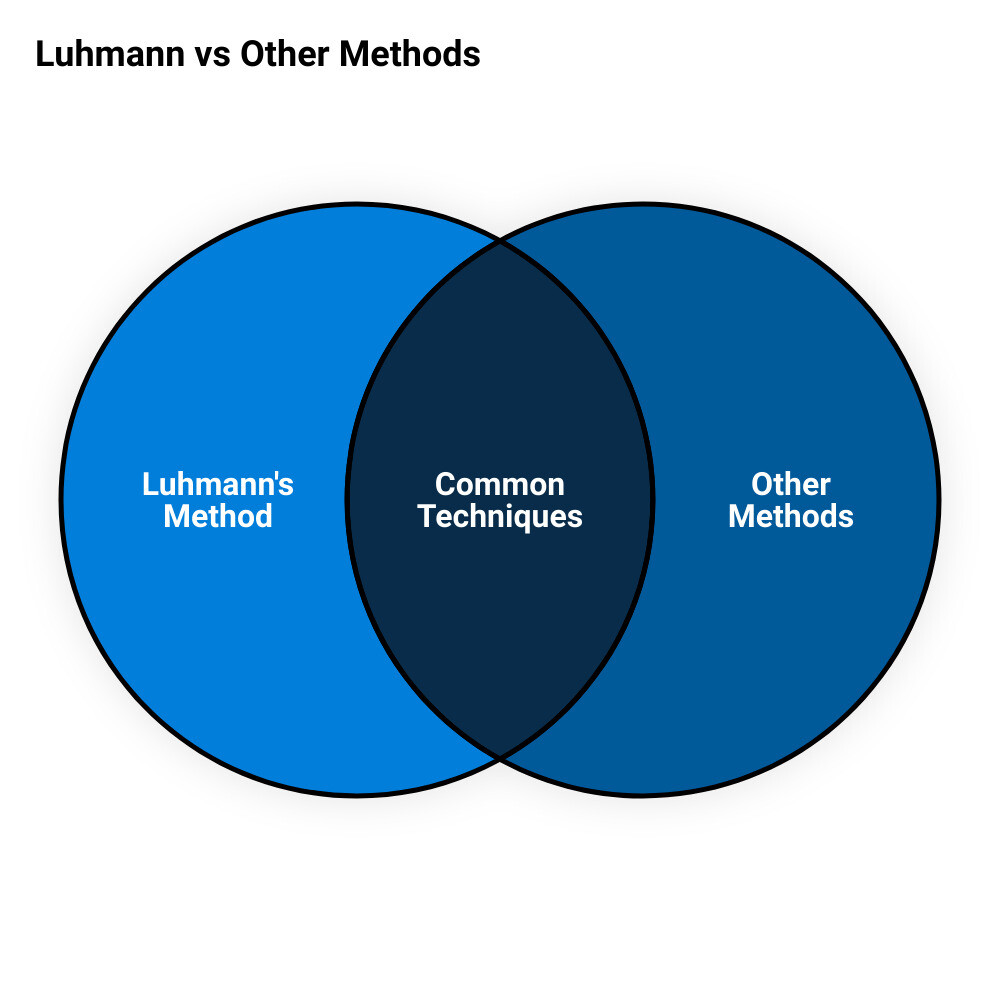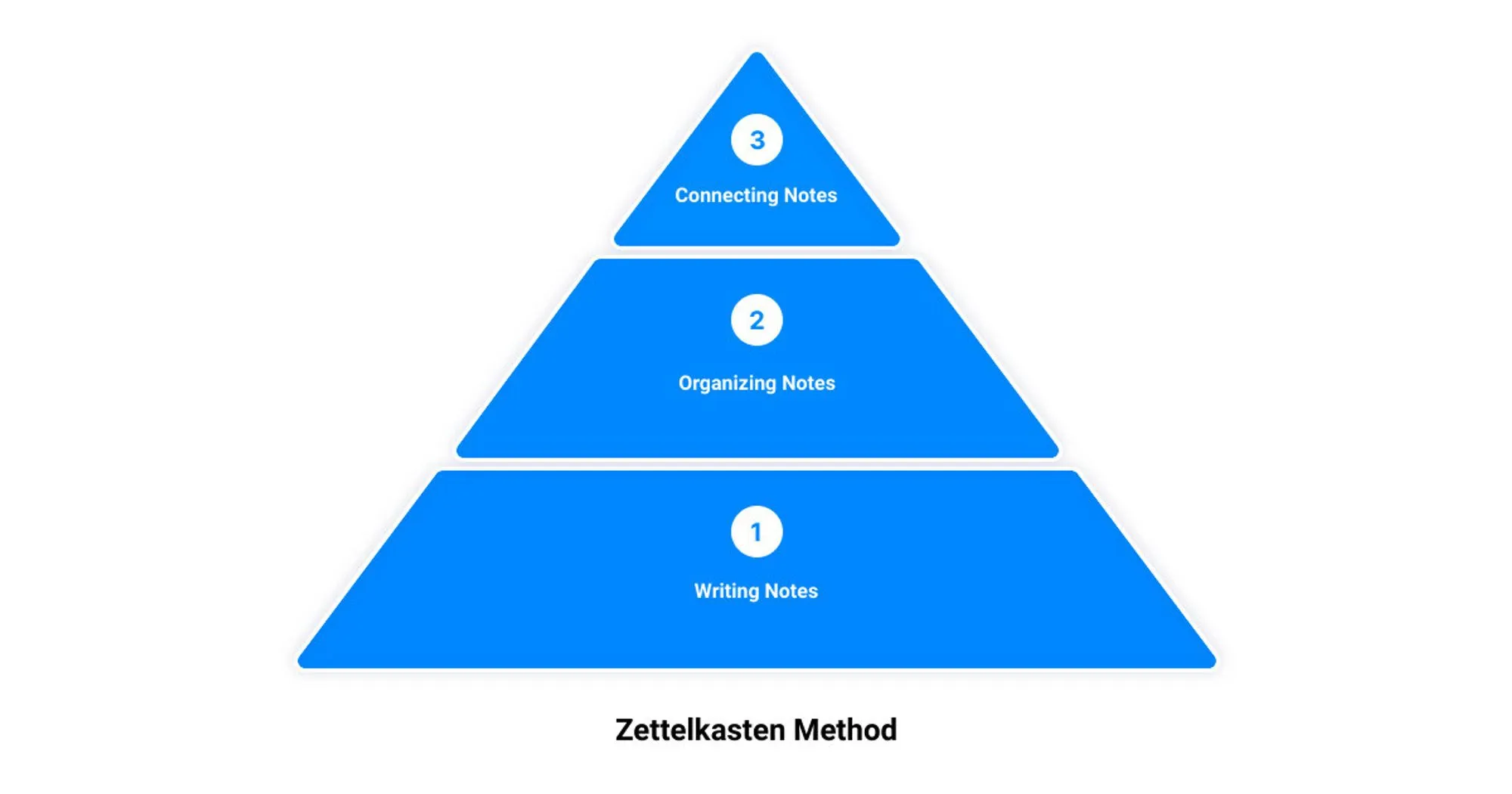Imagine being able to learn Mandarin or any other complex subject with greater efficiency, retaining information for a longer period, and having the ability to connect various ideas seamlessly. Sounds like an impossible feat? Well, it's not, and the secret lies in mastering a unique approach to note-taking developed by the German sociologist Niklas Luhmann. Welcome to our guide on Luhmann's note-taking method, a game-changing strategy that will revolutionize your learning journey.
Niklas Luhmann, a prolific scholar, developed a unique approach to note-taking that enabled him to write over 70 books and more than 400 scholarly articles in his lifetime. His method, known as the Zettelkasten method, goes beyond traditional note-taking techniques, focusing on creating a system that fosters continuous learning and creativity.
In the realm of cognitive science and learning strategies, Luhmann's note-taking method stands out for its ability to enhance information processing, promote idea connectivity, and increase productivity. This guide aims to shed light on this fascinating method, offering practical steps to implement it and advice on how to use modern tools like the Traverse app to support your learning.
Whether you're learning Mandarin Chinese characters, diving into the complexities of quantum physics, or exploring the nuances of philosophy, Luhmann's note-taking method offers a powerful tool to master any field. Join us as we delve into the intricacies of this method, and embark on a journey towards enhanced productivity and efficient learning.
Understanding the Zettelkasten Method
When it comes to mastering complex subjects or increasing your productivity, the Zettelkasten method, pioneered by Niklas Luhmann, stands out as a unique and effective approach. Let's delve deeper into understanding this fascinating concept.
Definition of Zettelkasten
The term 'Zettelkasten' is German for 'slip box', and it aptly describes the essence of this method. In the simplest terms, a 'Zettel' is a slip or note of paper where information we wish to retain is written. This system transcends the traditional method of note-taking by creating a web of interlinked thoughts, enhancing connectivity and fostering a deeper understanding of the subject matter. It emphasizes connection over collection, making it a potent tool for learning and knowledge retention.
The Role of Zettelkasten in Luhmann's Work
Niklas Luhmann, a prolific social scientist, is credited with popularizing the Zettelkasten method. He published over 50 books and 600 articles during his lifetime, and he attributed his remarkable productivity to his partnership with his Zettelkasten. His note collection wasn't just a repository of information; it was a hypertext that he could navigate, surf, and interact with, leading to the creation of new ideas and concepts. This unique framework made his work more efficient, enabling him to produce a substantial body of work with less time but not necessarily less effort.
The Structure of a Zettelkasten
At its core, a Zettelkasten comprises notes or 'Zettels' that are interconnected through a unique identifier. Each Zettel contains a body of knowledge and is linked to other related Zettels, creating a web of thoughts. The unique identifier, often a sequential number or a timestamp, serves as a fixed address for each note, aiding in easy navigation and retrieval of information. This interconnected system of notes enables learners to see the bigger picture and understand the intricate relationships between different pieces of information.
The beauty of the Zettelkasten method lies in its flexibility. It can be implemented using physical index cards or digitally through software. Regardless of the medium used, the method's foundational principle remains the same: creating an interconnected web of thoughts to foster deep learning and enhance productivity.
In the next section, we'll explore the manifold benefits of using Luhmann's note-taking method and how it can revolutionize your learning process.

The Benefits of Using Luhmann's Note Taking Method
Unleash the untapped potential of your mind with Luhmann's note-taking method, a note-taking strategy that has proven itself to be a game-changer in the realm of knowledge management. This method does more than just help you keep track of your notes; it transforms your learning process, boosting your productivity, and paving the way for the creation of a personalized knowledge database. Let's delve into the benefits that this revolutionary method offers.
Enhancing Connectivity of Thoughts
One of the standout features of Luhmann's note-taking method is its ability to enhance the connectivity of your thoughts. Unlike traditional note-taking methods, the Zettelkasten method encourages the creation of links between ideas, creating a hyper-textual network of knowledge. This interconnected web of ideas paves the way for new insights, as it allows you to identify unexpected connections and relationships between different pieces of information. Remember, insights don’t occur in isolation; they spring from the combination of old ideas in new, unexpected ways.
Increasing Productivity
In the world of Luhmann note-taking, productivity is king. The Zettelkasten method streamlines your workflow by providing clear guidelines on how to process and organize information. By reducing friction in your workflow, this method makes it easier for you to enter a state of flow, which can significantly boost your productivity. In fact, many Zettelkasten users, including Luhmann himself, dedicated specific days of the week to working with their Zettelkasten, allowing themselves to fully immerse in the process and reap the benefits of increased productivity.
Tackling Complex Problems
The Zettelkasten method is particularly effective when it comes to grappling with complex problems. It's all too easy to become overwhelmed when trying to juggle multiple strands of thought at once. However, Luhmann's note-taking method allows you to break down complex issues into smaller, more manageable parts. You can then step back and view the problem from a wider perspective, making it easier to identify patterns and connections that can lead to solutions. This method can scale itself automatically to the size of the problem at hand, preventing your notes from becoming a disorganized mess.
Facilitating Lifelong Learning and Creative Output
Finally, Luhmann's note-taking method is a powerful tool for lifelong learning and creative output. Even if your notes don't immediately contribute to a current project, they lay the groundwork for future endeavors. Each note deepens your understanding of a topic, preparing you for potential future projects and enhancing your learning over the long term. Moreover, the Zettelkasten method can significantly improve your writing, helping you to craft more coherent, persuasive, and engaging content by keeping your thoughts alive and accessible.
In conclusion, using Luhmann's note-taking method can lead to more connected thinking, increased productivity, an enhanced ability to tackle complex problems, and a boost in lifelong learning and creative output. As you embark on your learning journey - be it mastering Mandarin, diving into the world of cognitive science, or anything else - this method could be the powerful ally you need.

Practical Steps to Implement Luhmann's Note Taking Method
If you're ready to take your learning to the next level, brace yourself for a deep dive into the practical steps to implement Luhmann's Zettelkasten method. Whether you're learning Mandarin or any other subject, these steps can supercharge your study sessions, increasing your efficiency and productivity.
Setting Up Your Zettelkasten
The first step in setting up your Zettelkasten is understanding its structure. This unique system consists of four main types of notes: Fleeting Notes, Literature Notes, Permanent Notes, and Index or Structure Notes. Each note type has a specific role, and together they form a powerful learning tool.
Writing and Organizing Notes
Next, let's dive into writing and organizing notes. Remember, a Zettelkasten isn't just a place to store information. It's about creating a web of thoughts and emphasizing connection over collection.
For Fleeting Notes, the goal is to record your ideas quickly without disrupting your momentum. These are quick scribbles or thoughts you capture throughout the day while reading or thinking.
Literature Notes are made while you're diving deep into a specific resource, such as a book or article. The essence of these notes lies in understanding the concept and rewriting it in your own words.
Permanent Notes are the polished, distilled ideas that you want to explore further. Creating these notes is a thoughtful process. Each time you add a new permanent note, consider how this new information adds, supports, or contradicts your existing knowledge.
Finally, Index or Structure Notes act as signposts to help you navigate through your Zettelkasten.
Formulating Questions Based on Your Notes
Once you've written and organized your notes, it's time to formulate questions based on them. This is where you actively engage with the material, pushing your understanding and sparking new ideas.
Answering Your Questions in Your Own Words
After formulating your questions, answer them in your own words. This ensures that you truly understand what you're learning and allows you to articulate the ideas in a way that makes sense to you.
Reflecting on What You've Learned
Don't rush to the next topic after answering your questions. Take a moment to reflect on what you've learned. This step is crucial for deepening your understanding and making the knowledge truly yours.
Summarizing Your Notes
Summarizing your notes is another key step in the Zettelkasten method. This helps you distill the essence of what you've learned, making it easier to review and recall in the future.
Reviewing Your Notes Regularly
Finally, make it a habit to review your notes regularly. This helps you remember what you've learned and allows you to make new connections between different ideas.
By following these steps to implement Luhmann's note taking method, you're well on your way to mastering a powerful tool for enhancing your learning and productivity.
Using Traverse App to Implement Luhmann's Note Taking Method
Harness the power of Niklas Luhmann's note-taking system with the cutting-edge Traverse app, designed with features that support Luhmann's method and boost your learning efficiency. Let's delve into how you can leverage this tool to supercharge your learning journey.
Features of Traverse App that Support Luhmann's Method
The Traverse app offers a multitude of features that make it a perfect tool for implementing Luhmann's method. Firstly, it offers an innovative approach to note-taking, allowing you to create and link notes across various topics, similar to Luhmann's Zettelkasten method. It's like having your own digital Zettelkasten!
Moreover, the app encompasses mind mapping capabilities, letting you organize your thoughts visually, just as Luhmann's method promotes the visualization of connections between ideas. With Traverse, you can create directional links, name them to clarify relationships, color-code for easy identification, and arrange nodes freely to reflect your understanding.
Importing Anki Decks for Continued Learning
Anki is a popular spaced repetition flashcard app that many learners use for memorization. Traverse has taken it a step further by allowing you to import your Anki decks, ensuring continuity in your learning process. This way, you can keep all your study resources in one place, making it a seamless blend of note-taking, mind mapping, and flashcard reviewing.
Learning Mandarin Chinese with Traverse and Mandarin Blueprint
Imagine combining the power of Niklas Luhmann's note-taking method with the mastery of Mandarin Chinese! Traverse provides an opportunity to learn Mandarin, including Chinese characters, using the Traverse method. You can apply Luhmann's method to group related topics, connect ideas, and create a visual map of your language learning process.
The app also collaborates with Mandarin Blueprint for an enhanced learning experience. This partnership has led to higher-converting and more engaged learners who rave about their Mandarin course.
In conclusion, the Traverse app is an excellent tool for implementing Luhmann's note-taking method, and it provides additional benefits that can supercharge your learning process. Whether you're tackling Mandarin or any other subject, Traverse can help you master Luhmann's method for enhanced productivity.

Comparing Luhmann's Note Taking Method with Other Methods
Now, let's take a moment to compare Luhmann's note-taking method with some other, more traditional methods. Understanding these different approaches can further underscore the uniqueness and efficiency of Luhmann's Zettelkasten system.
Leonardo da Vinci's Note Taking Method
First up, we have Leonardo da Vinci, a man renowned for his boundless creativity and innovation. Da Vinci, like Luhmann, also had a distinctive note-taking approach. He famously wrote his notes in mirror writing, from right to left, possibly to keep his ideas unreadable to anyone but himself. This method, while undoubtedly unique and fascinating, is very personal and hence not easily adaptable for other learners.
Unlike da Vinci's method, Luhmann's note-taking system encourages open-endedness and easy retrievability. It allows you to create an interconnected web of ideas and fosters creativity and problem-solving. Its flexibility and structure make it easily adaptable to any subject, from sociology to Mandarin Chinese.
Traditional Note Taking Methods
Next, let's look at some traditional note-taking methods. These usually involve linear, chronological, or thematic organization, often lacking the connectivity and flexibility of the Zettelkasten method. Traditional methods can be adequate for straightforward topics or short-term projects, but they fall short when dealing with complex subjects or lifetime learning.
For instance, traditional methods typically involve summarizing information, which can lead to loss of context or missing out on potential connections between ideas. The Zettelkasten method, on the other hand, encourages you to write atomic evergreen notes, capturing a single idea per note, which can then be easily cross-referenced and linked to other ideas. This approach not only aids in information recall but also promotes a deeper understanding of the subject matter.
In conclusion, while traditional and other unique note-taking methods have their merits, Luhmann's note-taking stands apart due to its focus on connectivity, lifelong learning, and creative output. It's a method that facilitates an active, engaged learning experience, encouraging you to draw connections between ideas and fostering a deeper understanding of the subject matter. As you continue your journey towards mastering Mandarin or any other subject, embracing Luhmann's method can significantly enhance your productivity and learning outcomes.
Conclusion: Mastering Luhmann's Note Taking Method for Enhanced Productivity
In the quest for enhanced productivity and effective learning, the Zettelkasten method developed by Niklas Luhmann stands as a testament to the power of meticulous note-taking. This method, with its emphasis on creating interconnected networks of ideas and fostering deep understanding, is more than just a note-taking strategy. It's a lifestyle choice, a way of organizing your thoughts and knowledge that promotes lifelong learning, creativity, and efficiency.
Implementing Luhmann's method is not merely about jotting down notes; it's about building your personalized knowledge base, an interconnected web of ideas that grows and evolves with you. Whether you're learning Mandarin characters or diving deep into complex scientific theories, Luhmann's method enables you to capture insights, make meaningful connections, and drive your learning process effectively.
If you're serious about increasing your productivity and turning your notes into a powerful tool for thinking, it's time to consider adopting Luhmann's note-taking method. With a little practice and the right tools, such as the Traverse App, you'll be well on your way to creating your Zettelkasten, navigating through your knowledge as easily as you would surf the web.
Remember, the goal is not to accumulate an enormous collection of notes, but rather to create a meaningful structure that fosters understanding, sparks creativity, and ultimately enhances productivity. As you begin to see the connections between your notes, you'll find that the process of learning becomes less about memorization and more about understanding and exploration.
The journey towards mastering Luhmann's note-taking method may require effort, but the reward is worth it. With this method, you're not just learning; you're building a connected system of knowledge, a personal intellectual playground that will continuously fuel your curiosity, creativity, and productivity.
So, don't wait. Start building your Zettelkasten today and step into a new realm of learning and productivity.

